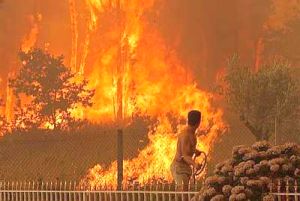
Workplace No Jewellery Program -
Tell Me About Jewellery-Related Burn Accidents and Injuries
17 July 2005 Source: The Star - Lifestyle: Health http://thestar.com.my/health/story.asp?file=/2005/7/17/health/11487580&sec=health
QUESTION #1: I RECENTLY read with horror about the subway and bus bombings in London. Many of the victims suffered burn injuries. What are burns?
A burn is an injury that damages your skin layers. There are many kinds of burns.
Firstly, there are thermal burns. These are caused by flames and flash (natural gas explosions, gas and propane) burns. Such burns can be caused by accidental fires, cooking mishaps, heaters, careless smoking or flammable liquids.
 |
Burn injuries are not only due to fires but can also be due to chemicals, contact with hot objects, electricity and chemicals. |
Then there are scalds, which are the most common type of burns. This happens when you spill hot liquid over your skin. If you spill it over your clothing and you fail to remove your clothes, the scald can be very severe because cloth retains heat. Note that even steam can cause scalds.
Contact burns are those due to skin contact with hot objects, such as a boiling kettle or a hot plate.
Electrical burns are those caused by electricity.
Chemical burns can occur in industrial accidents, or when you come in contact with battery acid and corrosive substances. Chemical burns cause progressive damage until the chemical is inactivated.
Ultraviolet burns are those caused by sunburn or overexposure to tanning equipment.
Inhalation burns occur when you are trapped together with toxic gas or fire and chemical fumes. Here, your respiratory tract is damaged when you breathe in the fumes.
 |
Inhalation burns occur when you are trapped together with toxic gas or fire and chemical fumes. Here, your respiratory tract is damaged when you breathe in the fumes, unless you're wearing a protective headgear. |
Note that even frostbite can cause burns
QUESTION #2: Can you die from burns?
Obviously yes, as proven time and again from those terrible stories you read about people being trapped in a burning building or burning automobile wrecks.
It all depends on the severity of your burns. These are divided into three categories.
First-degree burns are those where only the outermost layer of the skin (called the epidermis) is burned. However, the burn has not reached the deeper layer (called the dermis). In response to the burn, the skin gets inflamed, and thus there is swelling, redness, moistening and pain. There are rarely blisters.
First-degree burns usually heal within three to seven days. These are usually caused by sunburn and minor scalds. They almost never leave a scar.
Second-degree burns occur when the epidermis has been burned through and the deeper layer (dermis) has now been breached. In addition to the swelling, you now develop blisters. The skin is extremely red and splotchy, and the pain is severe.
Second-degree burns can damage the sweat glands and hair follicles, which lie within the deeper dermis. Such burns can be characterized as either superficial or deep. A superficial second degree burns heals within 10 to 21 days, but leaves a skin colour change and pigmentation.
Second-degree burns are usually caused by flames and flash burns, and bad scalds. They can result in scarring.
Third-degree burns are the most serious of all. Now, all the layers of the skin are burned through and the underlying subcutaneous fat cells may be affected. These burns are usually painless, because all the pain receptors in the skin have been destroyed. The skin now may be blackened with charring, or may even appear waxy white. There are no blisters.
These require skin grafting because there are no more skin cells left to produce new skin. These are usually caused by prolonged flame (like a burning house), severe scalds (especially when the clothing is not removed immediately after) and chemical and electrical burns.
QUESTION #3: Is there a fourth degree burn? I heard that term before while watching CSI.
Yes, though some classify this as very severe third-degree burns. Fourth degree burns involve the burning of muscle, bones or tendons. They are extremely dangerous and may require amputation of that particular limb.
QUESTION #4: Okay, say I have a minor burn. My mother told me I have to run tap water over it, right?
Your mother is right. Holding the minor burn under cool running water for 15 minutes will help cool the burn and reduce the swelling. You can also immerse the burn in cold water or cold compresses.
However, you should never put ice or ice water on your burn. This might cause further damage.
Once the burn has been cooled, you can apply a lotion, ointment or moisturiser on it to prevent drying. Antibiotic ointments can also be used. Then wrap it up loosely with a gauze bandage (not cotton, which can irritate it) to protect the skin.
If it gets infected, go to a doctor immediately. And use sunblock over the area for at least a year to avoid pigmentation. This is because burnt areas are sensitive to sunlight for up to year.
For major burns, go to the A and E department of a hospital immediately. If you have a minor burn on your face, hands, feet or genitals, or if the minor burn covers a large area, you should also go to the hospital immediately.
QUESTION #5: If I pull a person out of a burning house or vehicle, what should I do?
Have someone call an ambulance. If the victim is not breathing, you should do CPR. After youíve made sure the victim is breathing, you can proceed to remove clothing that is not stuck to the burn. But if the clothing is stuck, do not remove it unless it is smouldering, because you can actually remove a lot of skin.
For chemical burns, you should remove the clothing immediately. If you canít, then neutralize the area with lots of cool water.
Remove any jewellery near the burnt area because the skin will swell. Then flood the affected burn areas with cool water until the ambulance arrives.
Dr YLM graduated as a medical doctor, and has been writing for many years on various subjects such as medicine, health advice, computers and entertainment. The information contained in this column is for general educational purposes only. Neither The Star nor the author gives any warranty on accuracy, completeness, functionality, usefulness or other assurances as to such information. The Star and the author disclaim all responsibility for any losses, damage to property or personal injury suffered directly or indirectly from reliance on such information.
![]() Hmmm... Are your employees (workers) at risk of jewellery-related accidents and injuries?
Hmmm... Are your employees (workers) at risk of jewellery-related accidents and injuries?